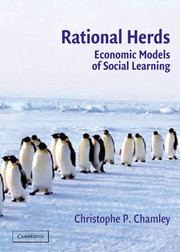14 - Sequences of Financial Trades
Published online by Cambridge University Press: 12 January 2010
Summary
Can exuberance be rational?
In this chapter, the actions that reveal private informations about the value of an asset are the agents' trades. In a model where agents are placed in an exogenous sequence, have different private information, and trade with the market (Glosten and Milgrom, 1985), the trading price provides a sufficiently detailed signal to prevent the occurrence of cascades. However, the pricemay be subject to large and sudden variations and to extended regimes with an incorrect valuation. Transaction costs may keep a large amount of private information hidden. Cascades may occur when agents act strategically in an auction.
Learning and herding have fascinated people at least since the tulip mania in the seventeenth century and the experiment of John Law. The standard line is that financial markets are wonderful pools in which information is shared efficiently between people. For Keynes, however, they were little more than casinos or “beauty contests” in which the main goal is not to learn intrinsic values but to guess what people think that other people think (and so on) has the greatest value.
Literary descriptions such as Keynes's have great allure. They arouse emotions, but they only titillate the rational mind. A proper assessment of the mechanism of learning and herding in financial markets requires the modelization of some rational behavior. The modeling task that is required is difficult because it must incorporate sufficient complexity to analyze how agents deal with this complexity, and yet at the same time be simple enough for analysis.
We have seen that the space of actions of the individuals defines the “vocabulary” used by the agents in their communication, and plays a critical role in the learning mechanisms.
- Type
- Chapter
- Information
- Rational HerdsEconomic Models of Social Learning, pp. 317 - 329Publisher: Cambridge University PressPrint publication year: 2003



